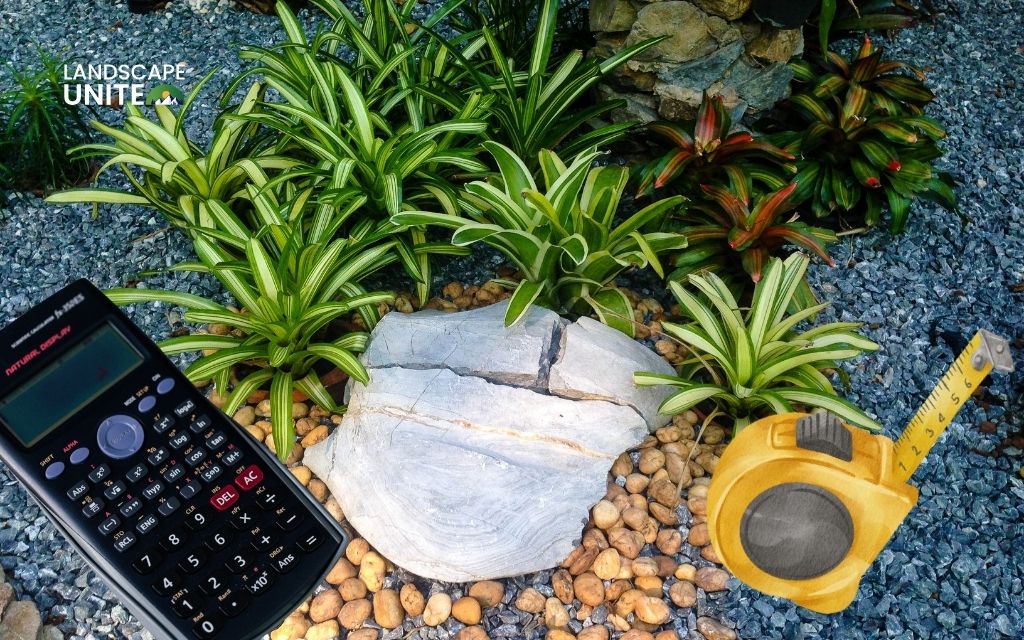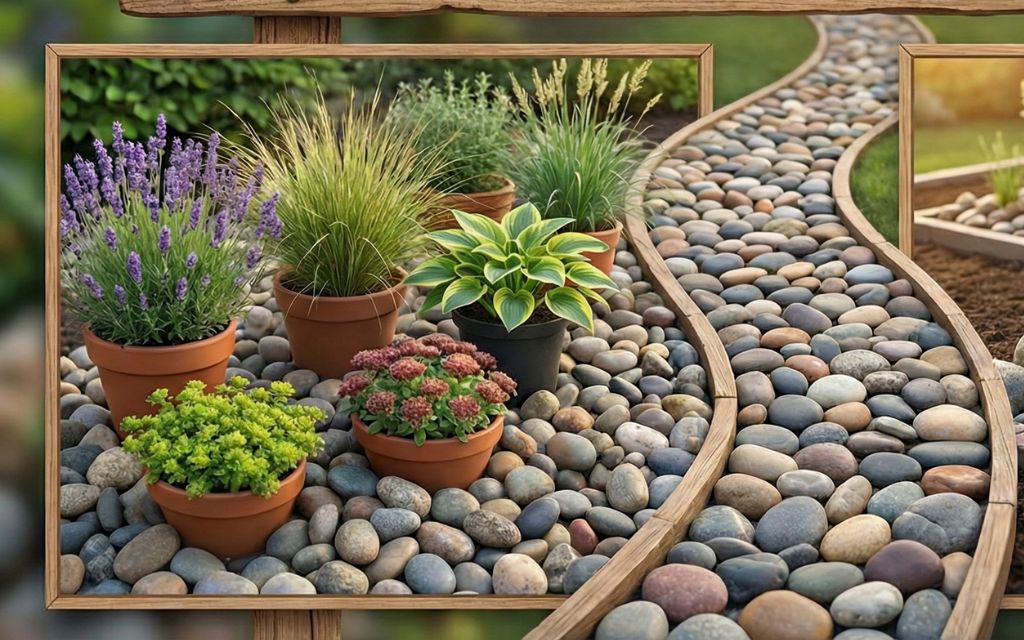Xeriscaping is water-efficient landscaping designed to conserve water through strategic plant selection and design techniques. Unlike traditional landscaping that relies on frequent watering and non-native plants, xeriscaping uses native species and efficient irrigation to create beautiful, low-maintenance gardens.
The 7 xeriscaping principles are:
- Strategic planning and design
- Soil improvement for water retention
- efficient irrigation systems
- Plant zoning by water needs
- Mulching for moisture conservation
- Limited turf areas
- Low-maintenance landscape management
These interconnected principles reduce water consumption by 50-75% while creating stunning, sustainable landscapes. Discover more details in this article.
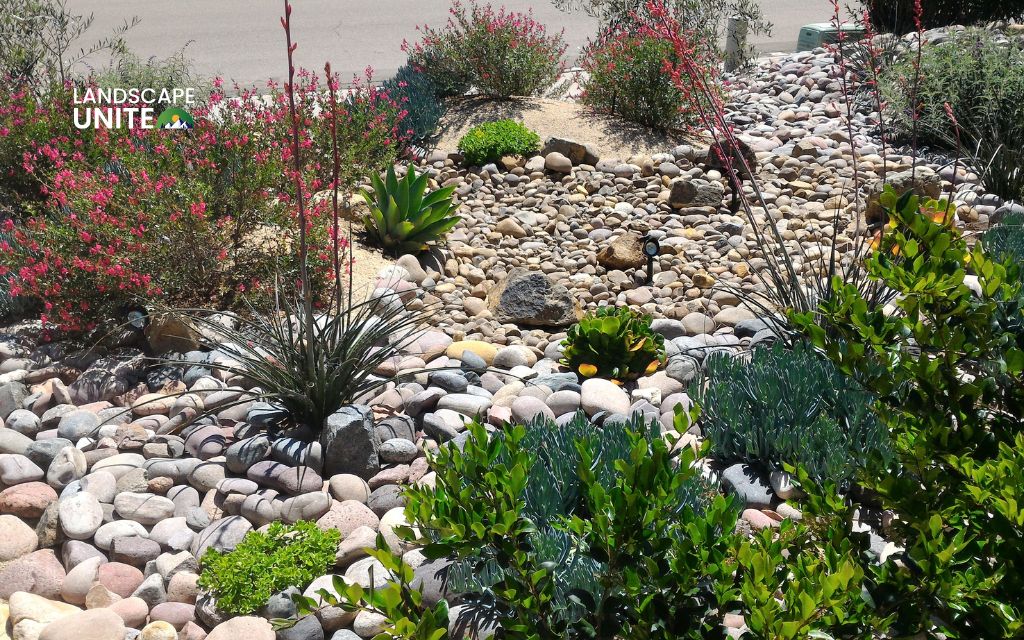
The 7 xeriscaping principles explained
These time-tested principles form the foundation of all successful xeriscape designs, promoting both function and beauty.
Each principle works together to maximize water efficiency while maintaining landscape beauty and functionality.
1. Strategic planning and design
The foundation of any successful xeriscape begins with thorough site assessment and thoughtful design. This crucial first step determines the long-term success and sustainability of your water-wise landscape.
Before selecting a single plant or installing any irrigation, you must understand your property’s unique characteristics and environmental conditions.
Site assessment: Evaluate sun exposure, soil drainage, and natural water flow patterns across your property.
Hydrozoning: Group plants with similar water needs together to optimize irrigation efficiency.
Design elements:
- Map microclimates (sunny, shady, wet, dry areas)
- Plan pathways using permeable materials
- Position high-water plants near patios for easy maintenance
- Use graph paper or digital tools for layout planning
Delve into smart ways to plan xeriscape garden in this article now.
2. Soil improvement for water retention
Healthy soil forms the backbone of any thriving xeriscape, serving as both the foundation for plant health and the primary mechanism for water storage and distribution.
Key principles:
- Focus on well-draining soil that retains adequate moisture
- Avoid over-amending soil for native plants
- Add compost only where needed for non-native drought-tolerant plants
Simple soil test: Squeeze moist soil in your palm. Clay soil holds together (retains water, may need drainage). Sandy soil falls apart (drains quickly, may need organic matter).
Drainage test: Dig a 12-inch hole, fill with water. Good drainage empties within 24 hours.
3. Efficient irrigation systems
Efficient irrigation in xeriscaping focuses on delivering water precisely where and when plants need it, minimizing waste while maximizing plant health and growth.
Best methods:
- Drip irrigation: Delivers water directly to root zones, reduces waste by 30-50%
- Soaker hoses: Cost-effective option for smaller areas
- Smart controllers: Adjust watering based on weather conditions
Uncover details about our drip irrigation installation for xeriscape in this blog.
Watering strategy:
- Water early morning (6-8 AM) to minimize evaporation
- Deep, infrequent watering encourages deep root growth
- Install rain sensors to prevent overwatering
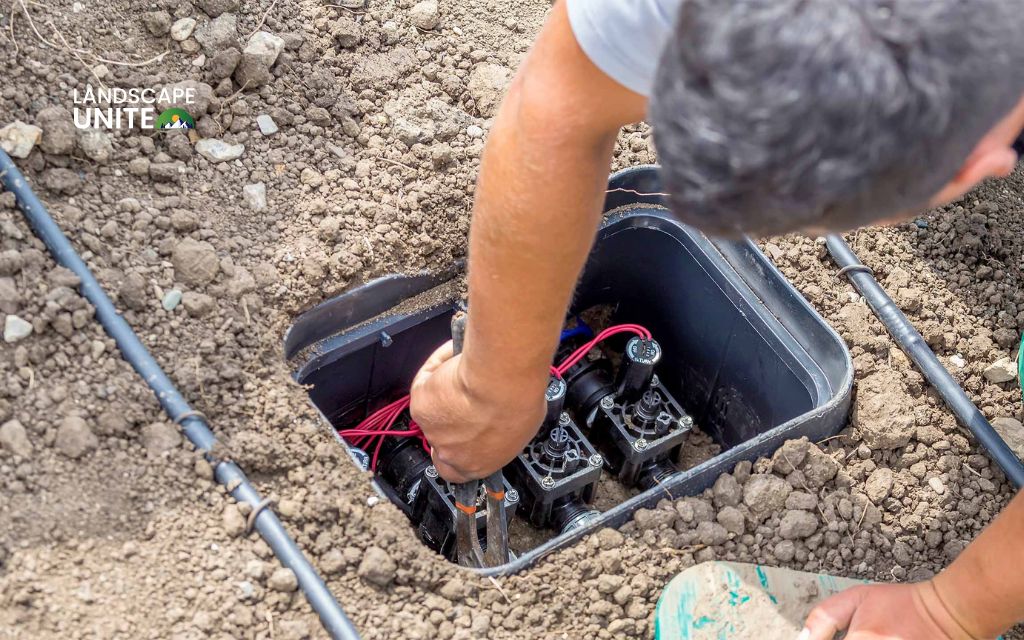
4. Plant zoning by water needs
Strategic plant selection and placement form the heart of successful xeriscaping, determining both the visual appeal and water efficiency of your landscape.
This xeriscaping principle requires matching plant water requirements to available moisture conditions while creating cohesive, attractive plant communities.
Focus on native and drought-tolerant species adapted to your climate:
Southwest (Arizona, New Mexico):
- Lavender, yarrow, blue grama grass
- Thrive in intense heat and alkaline soil
Rocky Mountains (Colorado, Utah):
- Penstemon, sedum, serviceberry
- Adapted to temperature extremes and high elevation
California Coast:
- Ceanothus, native sage, manzanita
- Suited to Mediterranean climate conditions
Avoid: High-water plants like traditional turf grass in dry climates.
5. Mulching for moisture conservation
Mulching serves multiple critical functions in xeriscape design, acting as both a water conservation tool and a landscape management strategy.
Properly applied mulch can reduce irrigation requirements by 25-50% while simultaneously improving soil health and reducing maintenance needs.
Benefits:
- Reduces water evaporation by 25-50%
- Suppresses weeds that compete for water
- Regulates soil temperature
Types:
- Organic: Bark chips, wood chips (decompose, add nutrients)
- Inorganic: Gravel, lava rock (permanent, no replacement needed)
Application: 2-4 inch depth, keep 3 inches away from plant stems to prevent disease.
6. Limited turf areas
Traditional American landscapes often feature expansive lawn areas that consume 30-60% of residential landscape water usage.
Xeriscaping dramatically reduces or eliminates these water-intensive turf areas while creating more diverse, interesting outdoor spaces.
Strategy: Use grass only where functional – play areas, pet spaces, high-traffic zones.
Alternatives:
- Native groundcovers for living carpets
- Gravel paths for walkways
- Native grass meadows for texture and wildlife habitat
Drought-tolerant turf options:
- Buffalograss (Great Plains regions)
- Fine fescue (shade-tolerant)
- Bermuda grass (hot, humid climates)
7. Low-maintenance landscape management
Contrary to common misconceptions, xeriscaping requires ongoing maintenance to remain healthy and attractive.
However, xeriscape maintenance differs significantly from traditional landscape care, focusing on seasonal adjustments and targeted interventions rather than weekly intensive care.
Seasonal maintenance schedules align with natural growth cycles and weather patterns.
Seasonal tasks:
- Spring: Check irrigation, prune, replenish mulch
- Summer: Monitor plant health, adjust watering
- Fall: Reduce irrigation, prepare for winter
- Winter: Minimal maintenance, plan improvements
Maintenance benefits: 40-60% less work than traditional lawns – no weekly mowing, minimal fertilizing, reduced pest control.
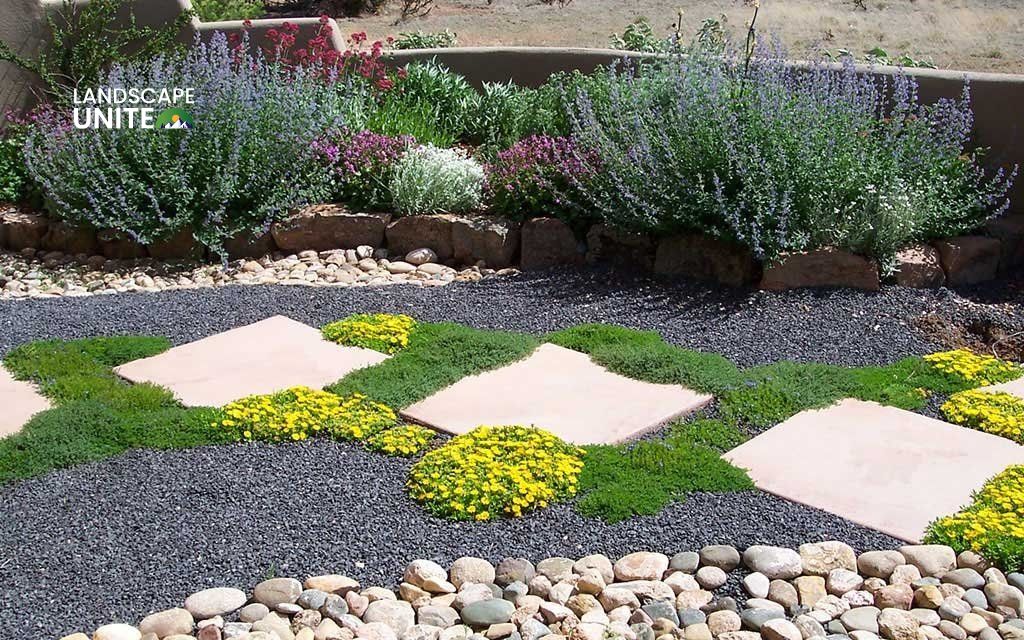
Why xeriscaping matters more than ever
The Problem: Water scarcity has evolved from a regional concern to a national crisis affecting communities across the United States. California’s ongoing drought conditions, Colorado’s water allocation challenges, and unprecedented heat waves throughout the Southwest have transformed water conservation from environmental consciousness to economic necessity.
Traditional landscapes use 30% of residential water consumption. Rising costs and drought conditions make water conservation essential.
Key benefits:
- Water Savings: 50-75% reduction in outdoor water use
- Cost Reduction: Lower water bills and maintenance expenses
- Environmental Impact: Supports pollinators and native wildlife
- Compliance: Meets water restriction requirements
- Beauty: Creates diverse, seasonally interesting landscapes
Ideal locations: Colorado, Arizona, New Mexico, Texas, California, and any region with water concerns or rising utility costs.
How to implement xeriscaping in your own yard
Actionable steps:
- Start small: Replace high-water lawn areas with drought-tolerant plants
- Install drip irrigation: Ensure consistent watering during plant establishment
- Choose native plants: Research species suited to your climate zone
- Phase projects: Spread improvements over multiple seasons
- Time planting: Fall planting allows root development before summer stress
Explore your complete xeriscape garden plan right here on this blog.
Tips for success:
- Group plants by water needs for easier maintenance
- Visit local botanical gardens for plant ideas
- Apply 2-4 inches of mulch around new plantings
- Water deeply but infrequently to encourage deep roots
Pro advice:
- Consider professional design for complex projects
- Check for municipal rebates on xeriscaping improvements
- Connect with local native plant societies for ongoing support
- Test soil conditions before making amendments
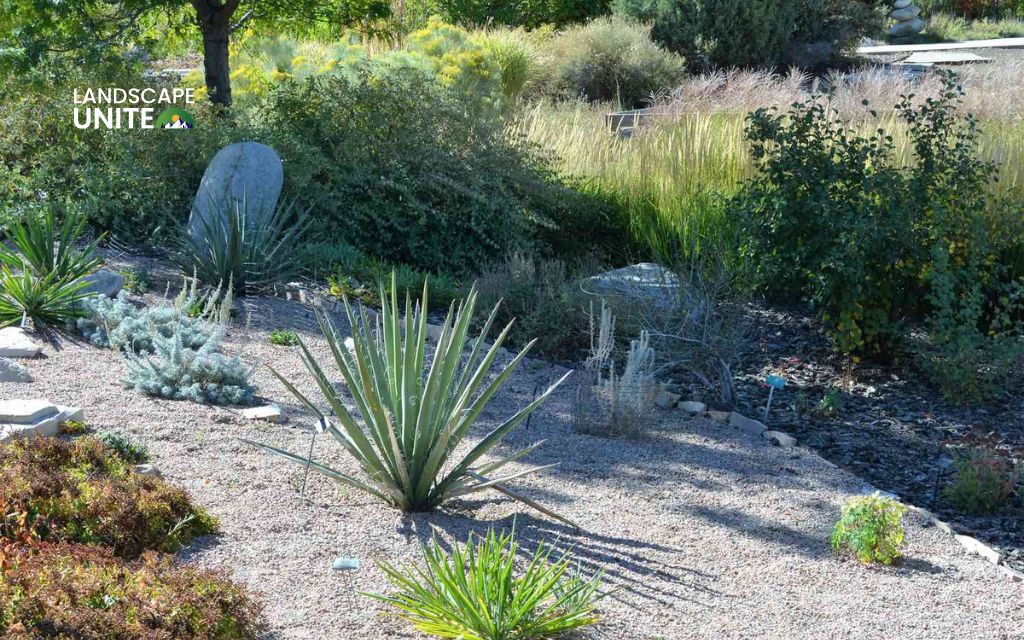
Conclusion
The 7 principles of xeriscaping – planning and design, soil improvement, efficient irrigation, appropriate plant selection, mulching, limited turf areas, and proper maintenance – create water-wise landscapes that thrive with minimal input.
Begin your xeriscaping journey by:
- Evaluate your current landscape for water-intensive areas
- Research native plants for your region
- Start with small, manageable projects
- Visit local xeriscape demonstrations for inspiration
Transform your water-hungry landscape into a sustainable, beautiful outdoor space that works with nature, not against it. Check out more from our resource library for region-specific guides and step-by-step landscape tutorials.
Frequently asked questions (FAQs)
What is the goal of xeriscaping?
The primary goal of xeriscaping is to create beautiful, low-maintenance landscapes that conserve water and reduce outdoor water usage by 50-75%.
Can xeriscaping be done on a budget?
Yes, xeriscaping is very budget-friendly and DIY-friendly. Choosing the DIY route instead of hiring a professional significantly reduces costs. Budget strategies include:
– Doing physical labor yourself
– Planting seeds instead of mature plants
– Choosing fast-spreading non-invasive plants
– Minimizing expensive hardscaping elements
– Using organic, homemade mulch
While professional xeriscaping costs $5-20 per square foot, DIY approaches can dramatically reduce these expenses.
Are xeriscapes only rocks and cactus?
No, this is a common misconception. Xeriscapes can be much more than collections of cacti and rocks – they can be lush, full of color, and diverse. Xeriscaping offers many design possibilities, from captivating flowering gardens to Mediterranean-style landscapes with herbs and colorful perennials.
How much water can I really save?
Xeriscaping can reduce water use by 50-75% compared to traditional landscaping. These savings translate to significantly lower water bills and reduced strain on local water resources.
Do I need a landscaper to start?
No, xeriscaping can be a successful DIY project. Xeriscaping is DIY-friendly, and you can design your backyard yourself and handle the physical labor with friends’ help. Start DIY with: Simple plant replacements, mulching projects, and small garden bed conversions. You can always consult professionals for specific elements while handling the majority of work yourself.
.
